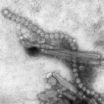(Press-News.org) A one-day prevalence survey of 183 hospitals found that approximately 50 percent of hospitalized patients included in the survey were receiving antimicrobial drugs, and that about half of these patients were receiving 2 or more antimicrobial drugs, according to a study in the October 8 JAMA, a theme issue on infectious disease. Most antimicrobial use was for infection treatment.
Despite the evidence supporting early, appropriate antimicrobial therapy, a substantial proportion of antimicrobial use in U.S. acute care hospitals may be inappropriate, based on factors such as lack of indication or incorrect drug selection, dosing levels, or treatment duration. Exposure to antimicrobial drugs is a risk factor for the acquisition of resistant and difficult-to-treat pathogens, and is a leading cause of adverse drug events. It is important to understand patterns of inpatient antimicrobial drug use in order to improve use and reduce antimicrobial-resistant infections, according to background information in the article.
Shelley S. Magill, M.D., Ph.D., of the Centers for Disease Control and Prevention, Atlanta, and colleagues performed an antimicrobial-drug use prevalence survey to determine the prevalence of inpatient antimicrobial-drug use, the most common antimicrobial drug types, and the reasons for their use. The one-day prevalence surveys were conducted in 183 acute care hospitals in 10 states between May and September 2011. Patients were randomly selected from each hospital's morning census on the survey date, and data were collected regarding antimicrobial drug use.
The study included 11,282 patients; of these, 5,635 (49.9 percent) were confirmed to have received 1 or more antimicrobial drugs at the time of the survey. Of this group of patients, 49.9 percent were receiving 1 antimicrobial drug; 32.7 percent, 2 antimicrobial drugs; 12.1 percent, 3 antimicrobial drugs; and 5.4 percent, 4 or more antimicrobial drugs.
Overall, of the patients receiving antimicrobial drugs, 75.9 percent were receiving them to treat infections; 19.0 percent for surgical prophylaxis; 6.9 percent for medical prophylaxis; and 6.9 percent for no documented rationale.
Although there were 83 different antimicrobial drugs administered to treat infections, just 4—parenteral vancomycin, piperacillintazobactam, ceftriaxone, and levofloxacin—made up approximately 45 percent of all antimicrobial drug treatment. These 4 drugs were not only the most common drugs for treating health care facility-onset infections and for treating patients in critical care units but were also the most common drugs for treating community-onset infections and patients outside of the critical care setting.
Additionally, approximately 54 percent of treatment antimicrobial drugs were given to treat lower respiratory tract, urinary tract, or skin and soft tissue infections only. "Taken together, focusing stewardship efforts on these 4 drugs and 3 infection syndromes could address more than half of all inpatient antimicrobial drug use," the authors write
"Results from this prevalence survey provide patient-level information that augments data on antimicrobial drug consumption and points to specific areas where interventions to improve antimicrobial use may be needed, such as vancomycin prescribing and respiratory infection treatment, supporting the CDC's recommendation that every acute care hospital implement an antimicrobial stewardship program."
"To minimize patient harm and preserve effectiveness, it is imperative to critically examine and improve the ways in which antimicrobial drugs are used," the researchers write. "Improving antimicrobial use in hospitals benefits individual patients and also contributes to reducing antimicrobial resistance nationally."
INFORMATION:
(doi:10.1001/jama.2014.12923; Available pre-embargo to the media at http://media.jamanetwork.com)
Editor's Note: Please see the article for additional information, including other authors, author contributions and affiliations, financial disclosures, funding and support, etc.
There will also be a digital news release available for this study, including the JAMA Report video, embedded and downloadable video, audio files, text, documents, and related links. This content will be available at 3 p.m. CT Tuesday, October 7 at this link.
Two randomized trials in the October 8 issue of JAMA examine new vaccination strategies for the prevention and control of avian influenza, often referred to as "bird flu." This is a theme issue on infectious disease.
In one study, Mark J. Mulligan, M.D., of the Emory University School of Medicine, Atlanta, and colleagues compared the safety and antibody responses (immunogenicity) of different doses of influenza A/Shanghai/2/13 (H7N9) vaccine mixed with or without the MF59 adjuvant (a component that improves immunogenicity and enhances efficacy of inactivated influenza ...
Despite no lapses in the disinfection process recommended by the manufacturer being identified, specialized gastrointestinal endoscopes called duodenoscopes had bacterial contamination associated with an outbreak of a highly resistant strain of E coli at a hospital in Illinois, according to a study in the October 8 JAMA, a theme issue on infectious disease.
The duodenoscope is different than that used for routine upper gastrointestinal endoscopy or colonoscopy. The procedure associated with these specialized scopes is endoscopic retrograde cholangiopancreatography (ERCP), ...
Study participants who reported tobacco use or had higher levels of biomarkers of tobacco exposure had a higher prevalence of the sexually transmitted infection, oral human papillomavirus type 16 (HPV-16), according to a study in the October 8 JAMA, a theme issue on infectious disease.
Oral HPV-16 is believed to be responsible for the increase in incidence of oropharyngeal squamous cell cancers in the United States. An association between self-reported number of cigarettes currently smoked per day and oral HPV prevalence has been observed, according to background information ...
Johns Hopkins scientists have shown a strong association between tobacco use or exposure and infection with oral human papillomavirus type 16 (HPV16), the sexually transmitted virus responsible for mouth and throat cancers worldwide. The numbers of such cancers have increased 225 percent in the United States over the past two decades.
HPV16 is found in 80 percent of cancers located in the back of the throat and is transmitted through oral sex. "The practice of oral sex is common, but this cancer is rare. So there must be cofactors in the process that explain why some ...
ANN ARBOR, Mich. — A decade ago, America's health care community took on heart attacks with gusto, harnessing the power of research and data to make sure that every patient got the best possible care.
It worked: Death rates for heart attack have dropped. The same has happened with heart failure and pneumonia. Now, say a pair of University of Michigan Medical School experts, it's time to do the same for sepsis.
Sepsis may not have the same name recognition as heart attacks -- but it now affects more hospital patients, and leads to more hospital costs, than any ...
An experimental vaccine to protect people against H7N9 avian influenza prompted immune responses in 59 percent of volunteers who received two injections at the lowest dosage tested, but only if the vaccine was mixed with adjuvant—a substance that boosts the body's response to vaccination. Without adjuvant, immune responses produced by the investigational vaccine were minimal regardless of vaccine dosage, according to findings from a clinical trial sponsored by the National Institute of Allergy and Infectious Diseases (NIAID), part of the National Institutes of Health.
The ...
A large, NIH-sponsored clinical trial of an experimental H7N9 avian influenza vaccine found an immune response that was believed to be protective in 59 percent of study participants who received two injections of the inactivated vaccine at the lowest dosage tested when mixed with an adjuvant – a component that boosts the body's immune response and enhances the effectiveness of inactivated influenza vaccines.
Participants who received a vaccine without the adjuvant had a minimal immune response.
The results are published in the Journal of the American Medical ...
VIDEO:
This video shows the sole of a shoe as it appears from different perspectives in rendering software. The shoe was placed upside down on an optical table (seen as flat...
Click here for more information.
Researchers at the National Institute of Standards and Technology (NIST) have demonstrated a laser-based imaging system that creates high-definition 3D maps of surfaces from as far away as 10.5 meters.* The method may be useful in diverse fields, including precision machining ...
(SALT LAKE CITY)—University of Utah biochemists have reported a new drug discovery tool against the Ebola virus. According to a study published in this week's online edition of Protein Science, they have produced a molecule, known as a peptide mimic, that displays a functionally critical region of the virus that is universally conserved in all known species of Ebola. This new tool can be used as a drug target in the discovery of anti-Ebola agents that are effective against all known strains and likely future strains.
The University of Utah (U of U) work, which was ...
The link between low average glucose blood levels and greater risk for severe hypoglycemia and hypoglycemic coma substantially declined between 1995 and 2012 in young Germans and Austrians with type 1 diabetes, according to a study published by Beate Karges and colleagues from the RWTH Aachen University, Germany in this week's PLOS Medicine.
The researchers obtained measurements of average blood glucose levels (measured as HbA1c) and the incidents of severe hypoglycemia and hypoglycemic coma from 37,539 children and young adults with type 1 diabetes between 1995 and 2012 ...

